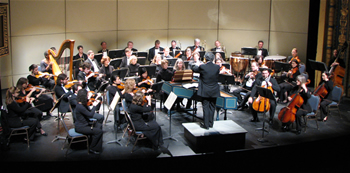North Carolina State’s University Theatre has opened a new show for the Christmas season now onstage at the Titmus Theatre in Thompson Hall. The show, newly penned by playwright Jacqueline Goldfinger, is an adaptation of Louisa May Alcott’s Little Women. The play was commissioned last year by the North Coast Repertory Theatre in California, and University Theatre’s acquisition of it is a coup for UT’s director John McIlwee. Directed by Allison Bergman, this adaptation culls from the novel a scant seven characters, including the four girls, their mother, and two “gentlemen callers.”
The show is set on a spectacular scrim-lined stage, which portrays the parlor of the March household. The setting comes in two parts: the actual set pieces of the living room, and a beautifully-crafted scrim on which is painted some of the most beautiful backdrops ever seen in a university theater. These scrim backdrops change the seasons and the locale when the girls venture out to someplace beyond hearth and home. While it is unusual for me to gush over sets, this particular scrim device is a true marvel, and one of the best aspects of a truly well-honed production. Kudos to the entire set team (it took a set crew of 19!) and to Scenic Artist Lauren Caddick, whose whimsical art graces this gorgeous scrim.
Little Women is set in Concord, New England, during the Civil War, and encompasses the Christmases of 1863 and ’64. The four girls come out first, Jo (Jordan Manning, Senior in Communications) leading the four into the living room as the evening of Christmas Eve begins. Beth (Jordan NeCamp, Freshman in Textiles) plays the piano while Meg (Leanna T. Hall, Sophomore, Information Technology) sews and Amy (Kathleen Caldwell, Freshman, First Year College) draws. The children’s mother, affectionately called Marmee (Kailey Harris, Junior, Psychology), enters shortly thereafter. Still to come in short order are Laurie (DeShawn Brown, Sophomore, Mechanical Engineering), the next door neighbor and best friend to Jo; and John Brook (David Johnson, Senior, Computer Science), Laurie’s tutor, who quickly becomes smitten by Meg, the eldest of the four girls.
Costumes have an important role in a historical play; these are gems from the considerable Costume Shop of UT. Hoop skirts float about the girls, while waistcoats and lace adorn the boys in proper genteel attire. Jennifer Dasher designed these nineteenth century beauties.
While the Civil War is the backdrop of the piece, it does not so much intrude upon the children as it does menace from afar. It has taken their father off to war, where he is wounded in act 1; this is cause for Marmee to leave the children and go to her husband’s side. It is this separation that causes Mr. March to refer to his children as “little women,” accentuating as gently as he can the need for them to be good to their mother in this time of trial and be “grown up” as possible. This admonition sometimes falls on deaf ears, as the children still squabble among themselves, have jealous fits at the good fortune of one or another, or try, as does poor Beth, to meet new people and not be afraid. The youngest, Amy, is chosen by their Aunt March to go to Paris to study Art, and the jealous streak this stirs in Jo belies the grown-up aspect of the girls’ lives.
This all-student production of Little Women is a truly memorable and enjoyable feat of theatre, and it is a joy to see the natural aplomb these cast members lend to their characters. Set on a beautiful stage that reminds one of the days before electricity, this play is a fine example of what can be accomplished by a university troupe. NCSU’s University Theatre has a reputation for taking theater to a higher level, but this production is evidence that, even at a college level, it is possible to create a near-flawless production.
Little Women continues through 12/4. For details, see the sidebar.











